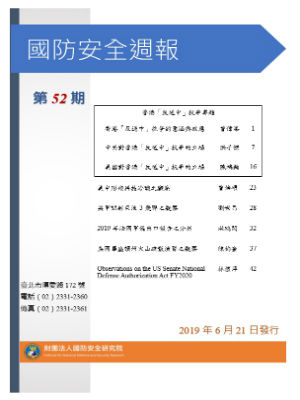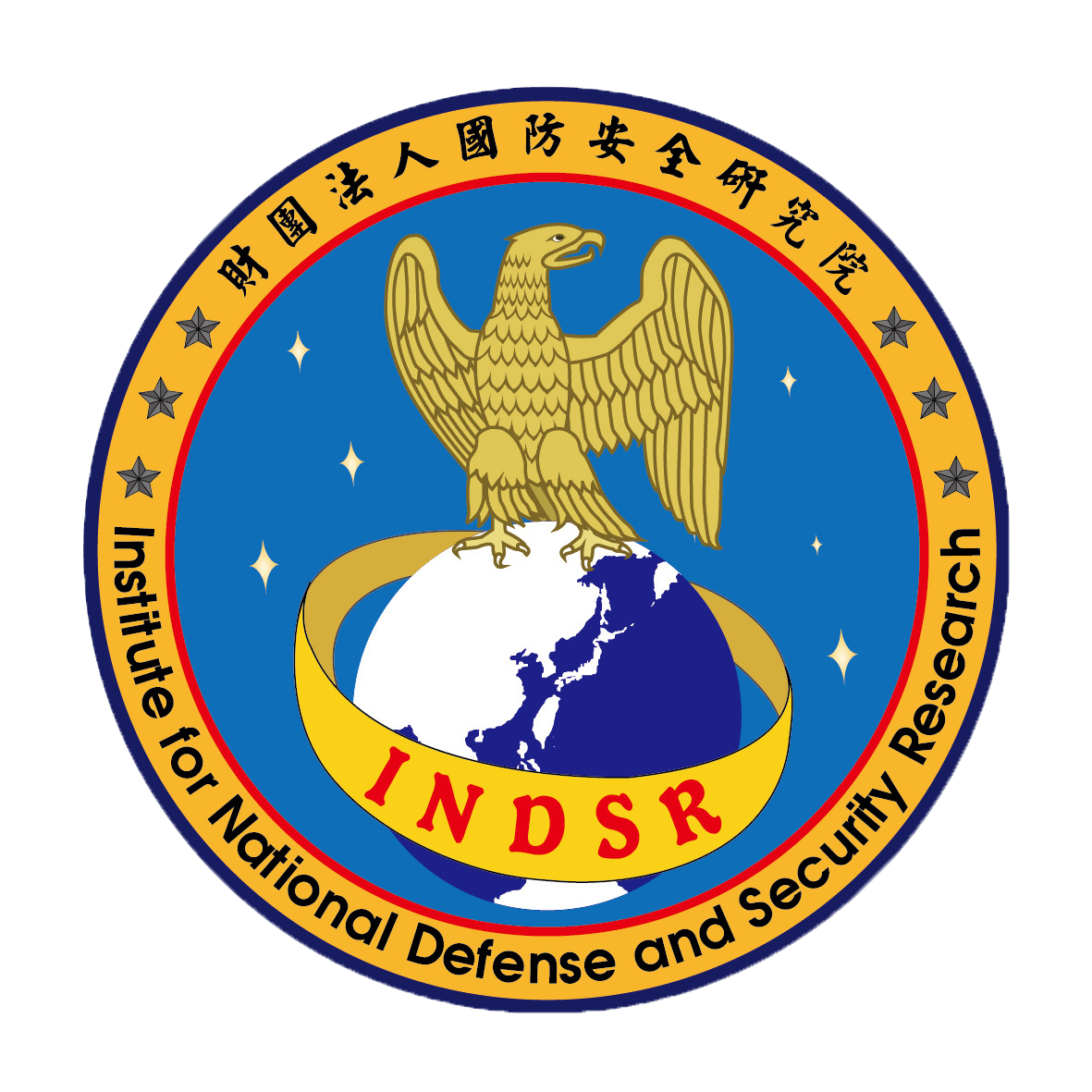Observations on the US Senate National Defense Authorization Act FY2020
2019.06.24
瀏覽數
190
壹、新聞重點
The US Senate Armed Services Committee (SASC) passed its version of the National Defense Authorization Act for the Fiscal Year 2020 (NDAA FY2020) on May 22, 2019 by a vote of 25-2. Although the text of the bill and the committee report have yet to be released, the bill’s summary is available for review.[1] The bill could be on the Senate floor for full Senate consideration the third or fourth week of June. The House Armed Services Committee on the other hand passed its version of the bill on June 13, 2019, by a vote of 33-24, with only two Republicans supporting the legislation. It is expected that SASC’s NDAA FY2020 will be passed by the full Senate first. Ideally, the Senate and the House should reach a deal for NDAA FY2020 before the fiscal year 2020 begins on October 1, 2019.
貳、安全意涵
1. SASC shows strong support for the White House’s defense budget against China
SASC is overwhelmingly supportive of the White House’s budget against China and Russia by a vote of 25-2. SASC’s NDAA FY2020 approves USD 750 billion for the administration’s defense budget. In fact, it spends a larger portion on China by highlighting the Army Multi-Domain Task Force’s (MDTF) significant role in the Indo-Pacific region and the posture site assessments in the Indo-Pacific region to accelerate the transition to smaller, dispersed, resilient and dynamic basing. SASC also requires a report on US defense requirements in the Indo-Pacific region, including a plan to fully resource US force posture and capabilities over the fiscal years of the 2022-2026 future years’ defense plan. SASC moreover modifies the annual report on Chinese military and security developments to include an assessment of Chinese overseas investment as it relates to their military and security objectives.
2. The US Army is leading the defense budget because of its new role in the Indo-Pacific strategy
Because of the US Army’s new and significant role in the Indo-Pacific strategy against China’s anti-access/area denial tactics, it is leading the defense budget and has been rewarded by SASC. In prioritizing strategic competition against China, SASC places MDTF for the Indo-Pacific region at the top of the list to develop capabilities and operational concepts to restore the US comparative military advantage in the region. SASC’s NDAA FY2020 also supports the transition of all funds for Terminal High-Altitude Area Defense procurement and sustainment from the Missile Defense Agency to the Army and encourages the Army to request funds to procure the eighth and ninth batteries beginning in fiscal year 2021. SASC moreover rewards the Army with critical Army weapons and combat vehicles. [2]
3. The US Navy is asked to be more flexible & forward-looking and to cost down
In authorizing funding to the US Navy, in contrast to the US Army, the US Navy has been asked by SASC to be more flexible and forward-looking as well as to cost down. For instance, in being more flexible and forward-looking, SASC’s NDAA FY2020 accelerates and incrementally funds procurement of light carriers, such as one Landing Helicopter Assault (LHA) replacement amphibious ship and one Landing Platform/Dock (LPD) Flight II amphibious ship, and demands a report from the Navy on alternative LHA and LPD acquisition strategies. SASC’s NDAA FY2020 also authorizes advance funding for an additional Virginia class submarine but likewise requires the Navy to update its acquisition strategy. In addition, the Navy has been asked to produce a report on the optimal composition of a carrier air wing in 2030 and 2040 and alternative force design concepts. In terms of reforming the Pentagon for greater performance and affordability, the US Navy has been requested to improve the technical foundation of shipbuilding programs to reduce delays, budget overages, and performance deficiencies and to prohibit funds from being used to procure additional ships above the Navy’s requirement and to implement stronger oversight for programs of record that have experienced significant reliability issues, cost growth, and/or schedule delays, such as the key systems on the Ford-class aircraft carriers. SASC’s stricter language on the Navy is perhaps also due to the fact that the Navy’s equipment is generally more expensive than that of other branches of the armed forces. Furthermore, as of February 8, 2019, the Navy still had not endorsed the battle concept on which the Army and Air Force had staked their future: Multi-Domain Operations. In sum, the Navy has been asked to be lighter and cheaper. [3]
4. A US Space Force within the Air Force is expected to be established
SASC’s NDAA FY2020 supports the White House’s proposal to establish a US Space Force within the Air Force in accordance with the National Defense Strategy outlined in 2018 that space is an increasingly contested warfighting domain, and Department of Defense (DOD) must have a cohesive strategy to protect America’s space capabilities and assets. A US Space Force within the Air Force therefore is expected to be established in the foreseeable future. SASC however differs from the White House on how the Space Force will become a military branch. SASC’s NDAA FY2020 initially makes the commander of US Space Command the head of the space force, instead of establishing a space force chief of staff as in the White House’s proposal. The commander of the US Space Command would work under the Air Force chief of staff. After at least a year, the Space Command and Space Force leader positions would be separated into two jobs, and the Space Force leader would join the Joint Chiefs of Staff. [4]
參、趨勢研判
1. Munition weaponry will be more emphasized than platform weaponry
As SASC’s NDAA FY2020 continues DOD’s work to maximize as many munitions production lines as possible—particularly those specific to the high-end fight in the Indo-Pacific region, such as the Long-Range Anti-Ship Missile (LRSM), Joint Air-to-Surface Standoff Missile Extended Range (JASSM-ER), the MK-48 torpedo, and Harpoon missiles, it is clear that munition weaponry will be more emphasized than platform weaponry as a trend. The development of comprehensive missile defense technologies to deliver integrated and effective capabilities to counter ballistic, cruise, and hypersonic vehicles has also been encouraged to continue. Furthermore, SASC has authorized an increase of more than USD 1.4 billion above the administration’s request for research, development, test and evaluation programs which includes directing investment to supersonic and hypersonic weapons systems and defense against such missiles from adversaries as well as authorizing USD 108 million to support a space-based sensor layer for missile defense purposes, among others. [5]
2. Artificial intelligence, hypersonics, and directed energy weapons will be the new policy development focus
SASC highlights the importance of the development of new capabilities such as artificial intelligence, hypersonics and directed energy. It has moreover been pointed out that technology development often outpaces policy formulation. SASC believes that DOD should better align policy formulation with technology development in order to promote responsible capability development. For instance, for artificial intelligence, a national commission was created in NDAA FY2019, but policy on how to maintain integrity of data are still lacking. For hypersonics, which is the highest technical priority of the Pentagon, as well as directed energy, policy regarding these use for offensive purposes still needs to be developed. As a result, new policy development focus will be on high-tech technologies such as artificial intelligence, hypersonics and directed energy. [6]
[1]US Senator Jim Inhofe, Chairman, and US Senator Jack Reed, Ranking Member, Senate Armed Services Committee, FY2020 National Defense Authorization Act, https://tinyurl.com/y2slq2n3
[2] Ibid., p. 8
[3] Ibid., pp. 6-7, 15; Sydney J. Freedberg Jr., “All Services Sign on to Data Sharing – But Not to Multi-Domain,” Breaking Defense, February 8, 2019, https://tinyurl.com/y6ku6sb4
[4] US Senator Jim Inhofe, Chairman, and US Senator Jack Reed, Ranking Member, Senate Armed Services Committee, FY2020 National Defense Authorization Act, https://tinyurl.com/y2slq2n3, p. 9; Scott Maucione, “Senate Committee Authorizes $750 billion defense budget, establishes space force,” Federal News Network, May 23, 2019, https://tinyurl.com/y33ng4yn
[5]US Senator Jim Inhofe, Chairman, and US Senator Jack Reed, Ranking Member, Senate Armed Services Committee, FY2020 National Defense Authorization Act, https://tinyurl.com/y2slq2n3, pp. 5, 8
[6] US Senate Committee on Armed Services, “SASC Completes Markup of National Defense Authorization Act for Fiscal Year 2020,” May 23, 2019, https://tinyurl.com/y5pewbc6


